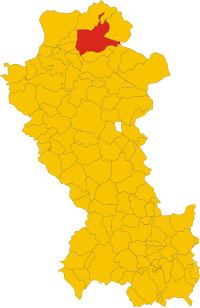Venosa
| ||||
|---|---|---|---|---|
Comuna | ||||
 | ||||
 | ||||
 Venosa Localização de Venosa na Itália | ||||
| Coordenadas | ||||
Região | ||||
Província | Potenza | |||
Área | ||||
| - Total | 169 km² | |||
Altitude | 415 m | |||
População | ||||
| - Total | 12 189 | |||
• Densidade | 72 hab./km² | |||
| Outros dados | ||||
| Comunas limítrofes | Barile, Ginestra, Lavello, Maschito, Montemilone, Palazzo San Gervasio, Rapolla, Spinazzola (BA) | |||
| Código ISTAT | 076095 | |||
| Código cadastral | L738 | |||
Código postal | 85029 | |||
| Prefixo telefônico | 0972 | |||
Padroeiro | | |||
| Sítio | www.comune.venosa.pz.it | |||
Venosa é uma comuna italiana da região da Basilicata, província de Potenza, com cerca de 12.189 habitantes. Estende-se por uma área de 169 km², tendo uma densidade populacional de 72 hab/km². Faz fronteira com Barile, Ginestra, Lavello, Maschito, Montemilone, Palazzo San Gervasio, Rapolla, Spinazzola (BA).
A cidade tem cerca de 10.700 hab. Venosa é a antiga Venúsia, pátria de Horácio.[1][2][3][4] Possui um castelo e uma catedral do século XV e uma abadia beneditina da Trindade, fundada no século XI.[1][2][3]
Pertence à rede das Aldeias mais bonitas de Itália.
Demografia |
| Variação demográfica do município entre 1861 e 2011[4] |
 |
| Fonte: Istituto Nazionale di Statistica (ISTAT) - Elaboração gráfica da Wikipedia |
Referências
↑ ab «Statistiche demografiche ISTAT» (em italiano). Dato istat
↑ ab «Popolazione residente al 31 dicembre 2010» (em italiano). Dato istat
↑ ab «Istituto Nazionale di Statistica» 🔗 (em italiano). Statistiche I.Stat
↑ ab «Istituto Nazionale di Statistica» 🔗 (em italiano). Statistiche I.Stat